
Digital Nomads – 5 Best Places in Belgium
The 5 Best Places for Digital Nomads in Belgium
Belgium might surprise you as one of the best places for digital nomads. The country has impressive internet connectivity, great coworking spaces and friendly expat communities. When you add in the diverse culture and history it’s a perfect combination.
In this article, you’ll discover the top five destinations in Belgium, ideal for your digital nomad lifestyle. With insights on internet speeds, community vibes and the best times to visit, you’ll be well-prepared to choose your next base to setup your laptop. Let’s explore Belgium’s most suitable spots for remote work and adventures.

Hey, I’m from the UK and I’ve been traveling full time for the last 2 years. I’ve traveled the UK and Europe in a self built campervan and most recently I’ve been backpacking through South East Asia. Whilst traveling I love to get out and explore the area by foot and one of my favourite places to hike is Malta. I am a real foodie and love trying the local cuisine wherever I stay.
Affiliate Disclosure: Some of the links on our site are affiliate links, meaning, at no additional cost to you, we may earn a commission if you click through and make a purchase. This helps us to continue providing valuable content and supports our efforts in bringing the travel community together. We only recommend products and services we believe in and think you’ll find useful. Complete details are included in our affiliate disclaimer. Thank you for your support!
In a Hurry? Here's our Key Info for This Article
- Antwerp is a top destination for digital nomads in Belgium due to its cultural scene and coworking spaces.
- Ghent offers a lively atmosphere and excellent WiFi speeds, perfect for remote work.
- Bruges is a picturesque location with reliable internet and a peaceful environment.
- Leuven is known for its academic vibe and numerous cafes and is therefore ideal for working.
- Brussels provides a mix of urban living and good connectivity, suitable for digital nomads.
Stay Connected
Things to Do
Essential Apps
Surfshark VPN
Stay safe online and continue accessing all your services just like back home.
Budget Tips
What is a Digital Nomad?
A digital nomad is someone who leverages technology to work remotely while exploring different parts of the world. With this flexibility, you’re not tied to a single location, and with the freedom to live and work in various places, you can happily hop between countries as you please. This lifestyle appeals to freelancers, entrepreneurs and remote employees who crave flexibility and adventure. In essence, you can be sipping coffee at a café in Paris one week and hiking in Iceland the next. Speaking of which, if you’re curious about other amazing spots to work remotely in and around Europe, I suggest checking out Iceland’s digital nomad hotspots.
This lifestyle isn’t just about travel but also about creating a work-life balance that suits you. The key tools you’ll need include a reliable laptop, a strong internet connection and often a coworking space to stay productive. We’ll cover some of the best places to setup your laptop in this guide along with handy tips to get the most out of your digital nomad trip to Belgium.
The 5 Best Places for Digital Nomads in Belgium
| Destination | Best for | Best Time to Visit | Average Wifi Speeds |
|---|---|---|---|
| Brussels | Cultural Activities | April to June | 100 Mbps |
| Antwerp | Networking | May to September | 90 Mbps |
| Ghent | Historic Sites | April to October | 85 Mbps |
| Bruges | Photography | May to August | 80 Mbps |
| Leuven | Student Life | March to May | 95 Mbps |
1. Brussels – Best for Cultural Immersion
We start this guide in Brussels, the capital city of Belgium. Often described as a melting pot of cultures and history, it brings a unique experience to the table. It’s known for its iconic landmarks and world-class cuisine and Brussels should be high on the list to visit for any traveler. But what does it hold for digital nomads? If you’re looking for a coworking spot to focus on some work, you won’t be far away from some fantastic ones, thanks to the many spaces that have popped up over the years. You’ll even find some open 24/7, and include a wide range of facilities to suit such as meeting rooms, private spaces and refreshments.
If coworking is not your thing, Brussels has a great selection of cafes and community spaces you can visit, where you can get your caffeine fix whilst working through your emails. And after a long days work, you are in one of the prime locations to wind down in a local bar and enjoy the Brussels nightlife.

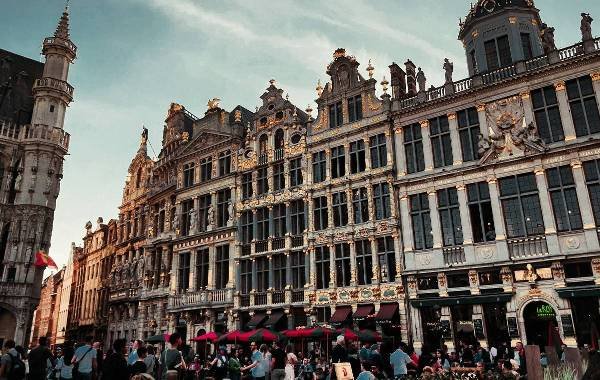
Top Attractions
As with many capital cities, you won’t be short of activities to keep you entertained in Brussels. The Grand Place is probably quite high on your list and for good reason. It’s undoubtedly the heart of Brussels, with its ornate guildhalls and the Town Hall that dates back to the 15th century. The Atomium, a futuristic structure built for the 1958 World Expo, provides panoramic views of the city and a great spot to snap some photos of this gorgeous city. Art lovers will appreciate the Magritte Museum, dedicated to the works of the surrealist artist René Magritte. For a taste of local life, visit the lively Place du Jeu de Balle flea market one morning and then go for an afternoon stroll through the picturesque Parc du Cinquantenaire, with its triumphal arch and museums.
Best Time to Visit
Spring and early summer, from April to June, are the best times to visit Brussels. This is due to the milder weather and you can experience the city in full bloom with its beautiful flower displays. If you time it right in August you may even get to see the Brussels Flower Carpet festival, where a huge flower carpet is made out of begonias. Autumn, from September to October, offers pleasant weather and fewer tourists, making it another great option.
Budgeting for Brussels
As the capital, prices can be slightly higher than other areas of Belgium. However, Brussels can still be enjoyed on various budgets. Accommodation ranges from $50 per night in budget hotels to $200 in more luxurious options. A meal at a mid-tier restaurant will cost around $25-$35. Public transport is efficient and affordable, with a one-day travel card costing approximately $8.
2. Antwerp – Best for Art and Fashion
The next city we take a look at is Antwerp, in the north of Belgium. This is a city famed for its artistic heritage and cutting-edge fashion scene. It offers a diverse range of attractions and experiences to suit all types of travelers and you certainly won’t be bored during your time here. For digital nomads there’s a great selection of coworking spaces and some have day passes available. This is perfect if you’re looking to network and meet like minded people during your trip but don’t want to commit to a monthly subscription. The Antwerp coffee scene is also pretty big, with many local and big chain cafes throughout the city. Caffenation has a couple of shops in Antwerp and these are a popular choice for laptop workers, with many digital nomads commenting on the chilled vibe and delicious coffees and pastries they serve.
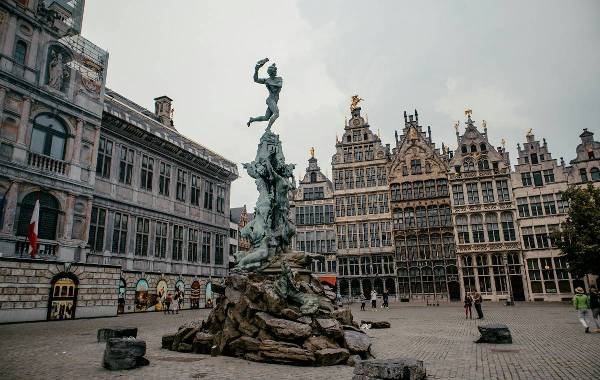
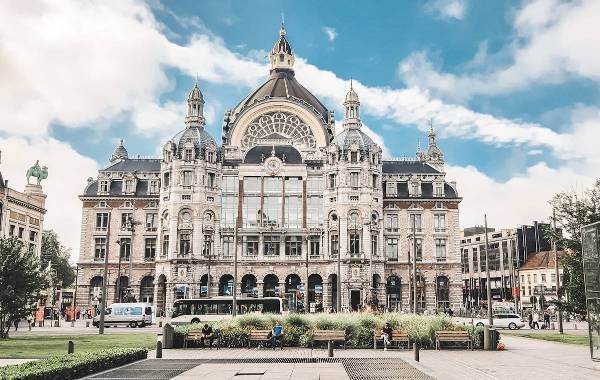
Top Attractions
Antwerp is home to numerous landmarks and places of interest. The Cathedral of Our Lady, a stunning example of Gothic architecture, houses masterpieces by the renowned painter Peter Paul Rubens. If you are looking for a fun activity with friends or family then Antwerp Zoo, one of the oldest zoos in the world, is a great option to explore. Art enthusiasts will appreciate the Museum aan de Stroom (MAS), which delves into the city’s maritime history and global connections. With Antwerp being one of the most fashion forward cities, the ModeMuseum (MoMu) showcases Antwerp’s influence in the fashion world. Also, don’t miss the historic Antwerp Central Station, an architectural must-see and regularly hailed as one of the most beautiful train stations in the world.
Best Time to Visit
The best time to visit Antwerp is during the spring (April to June) and autumn (September to October) months. These periods offer mild weather and fewer tourists. Summer can be crowded, although you can catch the Jazz Middelheim festival in August. Winter is chilly but festive with holiday markets and beautiful light displays.
Budgeting for Antwerp
Antwerp can be described as a mid-range destination in terms of cost, although budget options can definitely be found. Accommodation prices vary from around $50 per night for basic amenities to $100 to $150 per night for more mid-tier hotels. Dining at a standard restaurant typically costs about $20 to $30 per person. For those looking to explore more remote spots, digital nomad hotspots Hungary offers some great options. For now though, lets head to our next destination in Belgium.
3. Ghent – Best for History Buffs
When you first visit the city of Ghent, you’ll be struck by the city’s medieval architecture combined with its modern attractions. And with such a varied history and cultural scene, it houses some of the best places for digital nomads looking for affordable living and space to work remotely in Belgium. Similar to Antwerp, the coworking scene is vibrant, with creative spaces perfect for all kinds of remote worker. If you are within the creative industry, spaces such as Boldhouse have you covered, with studios and hubs designed to enhance your working environment, all housed in a beautiful building at an affordable rate. Ghent is also home to some really lovely cafes and coffee shops, giving you some great options to work remotely in the city.
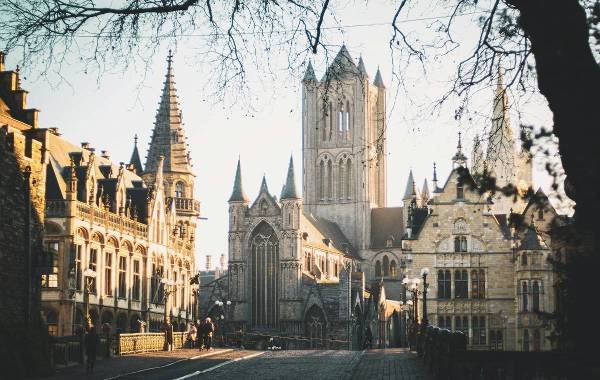
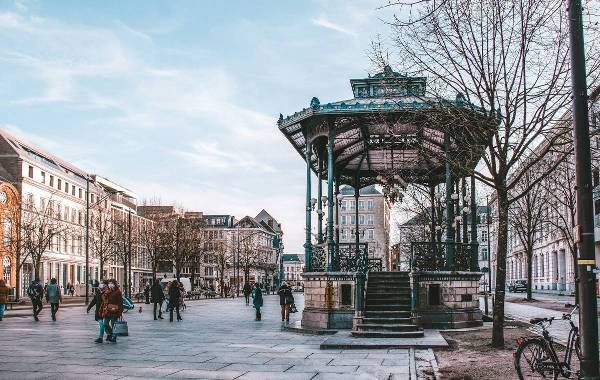
Top Attractions
As you wander through Ghent’s cobblestone streets, you’ll encounter the impressive Gravensteen Castle. This is a medieval fortress offering panoramic views of the city and a lovely spot to relax. The Saint Bavo’s Cathedral is home to the famous Ghent Altarpiece, an intricate work of art that draws visitors from around the globe. For a more modern experience, head to the Museum of Contemporary Art (SMAK), which showcases cutting-edge works and inspiring exhibitions throughout the year. Don’t miss a boat tour along the city’s canals. It’s a relaxing way to see the historic buildings and picturesque scenery and a nice escape away from work for a few hours. The Vrijdagmarkt square is another must-visit, surrounded by old guild houses and lively cafes. Perfect for a spot of people watching whilst enjoying a refreshing drink.
Best Time to Visit
Ghent is delightful year-round, but the best time to visit is during late spring and early autumn. The weather is mild, and you can enjoy outdoor festivals like the Gentse Feesten in July. This is particularly popular with solo travelers where you can enjoy music and dance as well as other cultural performances. Winter offers a quieter experience with cozy cafes and markets full of delicious foods and festive drinks, such as mulled wine and the famous Belgium hot chocolate.
Budgeting for Ghent
Ghent offers affordable living compared to other Belgian cities. Accommodation ranges from $50 to $150 per night for mid-tier hotels. A meal at a mid-tier restaurant costs around $20-$30. This makes Ghent a great option for digital nomads looking for an affordable yet engaging experience. By now hopefully you can see Belgium offers some great places to base yourself, whilst still allowing you to stick to your budget and make memories during your remote working trip.
4. Bruges – Best for Historical Charm
Bruges, often dubbed the “Venice of the North,” is a city that seems frozen in time with its medieval architecture and canal system. Its close proximity to the coast also makes it an ideal spot for those who love being close to the water. For digital nomads, the choice of coworking spots is more limited, however don’t let this put you off. There are many charming local cafes that are perfect to setup your laptop for a few hours. You’ll also find hostels and guesthouses that have rooms setup with desks and workspaces. This is ideal if you are looking to socialise and meet other remote workers during your trip. When you combine this with the range of funky bars and restaurants with live music, we think Bruges really is one of the best places for digital nomads to base themselves in Belgium.


Top Attractions
The selection of attractions in Bruges is pretty huge, and we’re sure you’ll find something to keep you entertained during your stay. The Belfry of Bruges stands as a prominent landmark; climbing its 366 steps not only provides a great bit of exercise, at the top you are rewarded with breathtaking views of the city. And with great views comes awesome photo opportunities, so don’t forget your camera! The Basilica of the Holy Blood, a stunning church, houses a relic believed to contain the blood of Christ.
Art and culture lovers will appreciate the Groeninge Museum, which features an impressive collection of Flemish and Belgian paintings. Additionally, the quiet Minnewater Park, also known as “Lake of Love,” provides a peaceful escape from your remote office. Don’t miss a boat ride through the canals for a unique experience. It’s a great way to unwind and appreciate the city’s beauty from a different view.
If you want to know more about Belgium and what to expect, then check out this full overview of the 10 things to know before travelling Belgium.
Best Time to Visit
The best time to visit Bruges is during late spring (May) and early autumn (September), when the weather is pleasant and the tourist crowds are thinner. Winter is enchanting with Christmas markets, although it can be chilly so be sure to bring some warm clothes. Don’t worry, we cover packing tips and tricks later on in this guide so stay tuned!
Budgeting for Bruges
Bruges can be moderately expensive, but still doable if you budget well. Expect to pay around $100-$150 per night for a mid-range hotel. A meal at a mid-tier restaurant will set you back about $20-$30 per person.
For more insights into nomad-friendly locations around Europe, check out the top Greek nomad spots.
5. Leuven – Best for Student Vibes
As a university city, Leuven is famous for its youthful vibe along with a vast history. This city is a mix of academia, historical architecture and lively cultural scenes, becoming a prime spot for digital nomads looking to work and play. Coworking spots can be found dotted around the city, making it one of the best places to meet other digital nomads in Belgium. Although, due to its student presence, finding a local library could be a better option. This is especially helpful if you need to get your head down for some focused work. Another possibility is to grab a table at a quiet cafe, and there’s certainly no shortage of these in the centre of Leuven. You’ll also find a good number of restaurants and bars with outdoor space, so if you are visiting during the summer months you can enjoy some alfresco working.


Other Places to Work Remotely in Europe
Top Attractions
Leuven offers a variety of attractions. The University Library, with its impressive tower, is a must-see. Then there’s the Oude Markt, often referred to as the longest bar in the world due to its numerous cafes and bars. Did someone say after work drinks? For a touch of tranquility, head to the Botanical Garden, Belgium’s oldest gardens and established in 1738. The M-Museum Leuven houses contemporary pieces of art, alongside classic works, and is a nice activity to clear your mind. Lastly, the Gothic architecture of St. Peter’s Church, really is a must visit, with its stunning display of the Last Supper painting by Dirk Bouts.
Best Time to Visit
Leuven is best visited in spring (April to June) or autumn (September to October). The weather is pleasant and the student population is active, giving the city a lively and buzzing atmosphere. Summer can be busy with tourists, while winter is quieter but colder.
Budgeting for Leuven
Leuven is relatively affordable compared to other Belgian cities. Expect to spend around $60-$100 per night on mid-range accommodations. A meal at a decent restaurant will cost about $15-$25. The city’s student population ensures that there are plenty of budget-friendly dining and entertainment options.
Local Cuisines
The culinary scene in Belgium is a delightful mix of traditional dishes with modern twists. A big part of traveling to new countries is experiencing the local food, and as a digital nomad this also provides the opportunity to socialise and meet other remote workers. Many cities offer food tours to help you find the best places to sample well known dishes. Here are some key meals to try when traveling around Belgium:
– Moules-frites: Mussels cooked in white wine or beer and served with crispy fries. An iconic Belgium dish served all over the country.
– Belgian waffles: Crispy on the outside and fluffy on the inside, these waffles are often topped with whipped cream, chocolate or fruit.
– Stoverij (Stoofvlees): A hearty beef stew cooked in Belgian beer. It’s well known for its rich and deep flavor and usually served with fries or bread to soak up the sauce.
– Speculoos: Spiced shortcrust biscuits that are a local favorite, particularly during the holiday season. They’re loved for their distinctive flavor and crunchy texture.
-Waterzooi: A creamy stew made with chicken or fish, vegetables and a broth. This dish is comforting and flavorful and perfect for colder days.
Packing Guides and Tips
It’s crucial to pack properly when planning your stint as a digital nomad in Belgium. The first thing to consider is the weather. Winters are mild with cool summers, since Belgium has temperate maritime climate. It’s always best to have versatile clothing options and for this reason we suggest layering up; don’t forget your waterproof jacket as it can rain quite often. Some comfortable walking shoes are key, especially if you intend on exploring cities like Bruges or Ghent by foot. When visiting cosmopolitan places such as Leuven or Antwerp, remember to bring a few dressier options.
A big consideration for travelling anywhere to make sure you are covered in case of emergencies. Safetywing, for example offers great coverage and is deigned for digital nomads.
Remember to Pack a Multi-Adapter Power Socket
Technology is another important aspect to keep in mind. For instance, Belgium generally provides reliable internet service but having a portable hotspot could be lifesaving during poor connections. A good laptop should be lightweight, yet strong enough for necessary work performance. Since Belgium uses Type E power plugs, you may also want to consider carrying a multi-adapter socket. My top tip would be to take noise cancelling headphones with you, because working in busy cafes or coworking spaces that are common in digital nomad hotspots is not always easy if you need to focus. Mine have been an absolute godsend for me when I need some concentration time. A camera is always a good idea, capture those memories. The insta360 has been so helpful when wanting to capture those memories while compact and lightweight which helps with professional travel.
Daily Life
Lastly, think about daily conveniences. A sturdy backpack that can fit your laptop and other essentials will make moving between workspaces easier, plus it can double up as a carry on during travel. Since Belgium is known for its excellent public transport, consider a reusable travel mug for your coffee or tea, which is perfect for those early morning commutes. Keep your important documents, like your digital nomad visa Belgium, safely stored and easily accessible. And if you plan to travel to nearby countries, don’t forget to check out digital nomad hotspots Germany for more work-and-travel opportunities.
Other Places to Work Remotely in Europe
Best Places for a Digital Nomad in Belgium – Concluding Thoughts
As we wrap up our journey through Belgium’s prime spots for digital nomads, it’s clear that Antwerp, Ghent and Brussels stand out. Each city offers its unique charm and resources, making them ideal for setting up your mobile office. And with the history and student scenes of Bruges and Leuven, we think you’ll easily find a place that aligns with your work, lifestyle and down time.
We hope this guide has given you all the information you need to find the best places in Belgium for digital nomads. With excellent connectivity, communities and cultural experiences, your digital nomad adventure is sure to be unforgettable. All thats left is to pack your bags, grab your laptop and get ready to experience the best of what Belgium has to offer.
Belgium’s Top 5 Digital Nomad Spots FAQ
We think some of the best places for digital nomads in Belgium include Brussels, Antwerp, Ghent, Bruges, and Leuven. Each offers excellent coworking spaces, communities and reliable internet connectivity.
Absolutely! Belgium’s central location in Europe, high quality of life and multilingual population make it one of the best places for digital nomads. Plus, the country’s efficient public transport system makes it easy to explore.
The cost of living can vary depending on the city. Brussels and Antwerp are generally more expensive, while cities like Ghent and Leuven offer more affordable options. On average, expect to spend around €1,500 to €2,500 per month. Please also take note of social norms to help with budgeting. The tipping culture in Belgium as an example.
Yes, Belgium has a growing digital nomads community with some of the best places to setup your remote office. Cities like Brussels and Ghent have numerous coworking spaces and meetups where you can connect with other remote workers. You can also check out Digital Nomad Hotspots in France for more options nearby.
If you’re from the EU, you won’t need a visa. Non-EU nationals may need a visa or residence permit depending on the length of stay. It’s best to check the latest visa requirements specific to your nationality.






















